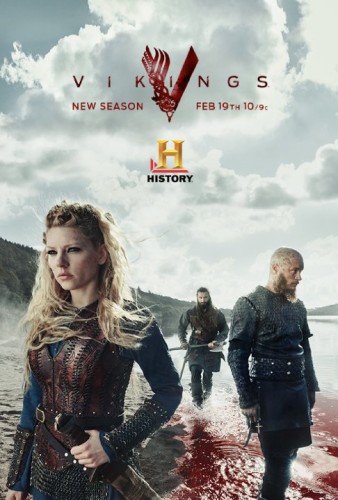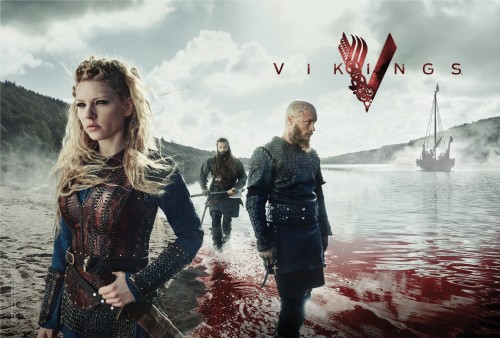This post by Lisa Bolekaja appears as part of our theme week on Violent Women.
It is rare to find films or television shows where women characters are actively violent without some cause. Conventional storylines that portray women resorting to violence are typically ones in which women are attacked, raped, or protecting loved ones, most likely children. Women are pushed to extreme acts of violence because of patriarchal dominance, or some form of outside threat that usually targets them because they are female and perceived as weak. Female passivity is the expected norm. Men “do” things, women have things “done” to them. The 80’s and early 90’s ushered in a bumper crop of American films portraying kickass women (mostly White—Pam Grier held it down for Black women in the 70s); however, given closer inspection, most of these violent women were reacting to something and not necessarily acting out.
In Reel Knockouts: Violent Women in the Movies, Neal King and Martha McCaughey assert that “cultural standards still equate womanhood with kindness and nonviolence, manhood with strength and aggression.” Under the Victorian cult of true womanhood, womanly virtue was supposed to encompass piety, purity, submissiveness, and domesticity. Thank goodness writer/producer Michael Hirst ignored those virtues by creating two dynamic women warriors with his historical drama Vikings. Writer Giselle Defares does a great job giving an overview of the show here, however my focus is on two particular women, both warriors (known as shieldmaidens on the show), who represent a new type of bad-assery that some feminists may argue replicate male domination and aggression. The women, Lagertha (Katheryn Winnick) and Porunn (Gaia Weiss) are two women warriors who derive pleasure and wield power by going to battle alongside their men. Real talk: sometimes a woman wants to knock the stuffing out of people and wreck shop just like the guys.
Watching these two women maneuver the world of the violent dark ages is fascinating because they are not constructed as emasculating or overly masculine women who need to be put in their place by their men (although it does occur on occasion). They are presented as Viking women who are part of the fabric of the violent society they live in who also further the goals of their aggressive Northen European/Scandinavian culture. They are providers of home and hearth, defenders of home and hearth, and will go raid some other country’s home and hearth to take what they want too. This egalitarian treatment of women as warriors is the best part of watching Vikings. Unlike the English or Parisian women who stay posted up on the show waiting for their men to defend them, Viking women are straight up in the mix, leading charges, and beating their enemies.
Lagertha: Baddest Chick in the Game
Lagertha Lothbrok is depicted in the first episode of the show as a typical farm wife caring for her two young children inside their humble abode in a place called Kattegat while her husband Ragnar is away on some manly quest. Two men, strangers, enter their home under the pretext of seeking food and warmth. It soon becomes clear that they are there to sexually harass and rape her. In any other historical drama, the woman may put up a valiant fight, only to be brutalized once she is overpowered. A husband/lover/shining knight may arrive to save the day at the last minute, or be spurned into action by man pain after their woman has been violated or murdered. Not so Lagertha. She sends her children outside, pretends to be compliant to the two men, and proceeds to fuck them up with kitchen utensils. In this moment we learn that:
- Lagertha does not need a male savior.
- Men may have to be saved from her fighting prowess.
- She likes to fight.
Lagertha physically fights with her husband Ragnar when he wants her to stay behind and care for their children when she would rather go on the raiding party into the new land of England. We’re talking real knock down, dragged out fisticuffs in the house. And she bruises Ragnar up pretty good as well, taking full hits from him like a boss. Even in the midst of their physical altercation, viewers can tell they really love each other. This aggression toward each other isn’t new, and they will most likely fight again about other raids Lagertha wants to participate in. She isn’t afraid to become violent to get what she wants. And Ragnar doesn’t expect her to back down ever.
Viewers want this couple to win in life and love (and oddly enough their domestic battles too), but when Ragnar becomes an Earl and later impregnates a woman from another clan, he tries to convince Lagertha to let him have two wives; Aslaug his new pregnant sidepiece, and herself in an egalitarian polyamorous household. Ragnar loves both women (but Aslaug mainly because she can have the sons that Lagertha’s body can no longer carry to term), however, Lagertha is too proud and full of self-respect. Once again, in any other movie or television show, Ragnar would most likely force Lagertha to obey him with threats of violence or death, or he would abandon her. Instead, Lagertha chooses to divorce him. Their young son, Bjorn, chooses to go with her. She literally leaves Ragnar standing in the dust crying over her and his beloved son as she rides off into a new land and life without him.
Lagertha’s warrior ways don’t leave her as she re-marries and eventually defies her new husband, the Earl of Hedeby, by bringing a phalanx of warriors to help her ex-husband Ragnar defeat a mutual enemy four years later. Once Lagertha gets word that Kattegat has been overrun and Ragnar (with his new wife and children) has fled to the hills, she comes to his rescue with their now grown son Bjorn doing what she does best: kicking ass and taking names. When her new husband tries to humiliate and sexually harass her in front of their court, Lagertha stabs him in the eye and snatches up his title and power, becoming the new Earl of Hedeby.
In her new position of authority over an entire people, Lagertha stands with the newly crowned King Ragnar by fighting with him overseas and sitting next to him at the seat of power with other Earls and Kings making strategic decisions on their planned raids. She helps Ragnar force an English King to negotiate monetary rewards and a new alliance. She leads a small contingent of fierce shieldmaidens on a secret night attack against the city of Paris that galvanizes the male Viking warriors after devastating setbacks in their battles against the French.
Lagertha claims her right to be a woman, mother, warrior, pagan, and political leader without gender constraints. Granted, her people do participate in patriarchal terrorism towards other countries and the women go along with it, but in the context of that culture, it is the norm, and shieldmaidens will kill women from other countries without hesitation. Nationhood supplants sisterhood on the battlefield. And as anti-feminist as that sounds, there is something to be said about bold women with agency, even if they are anti-heroes in someone else’s narrative. Many fans of the show (myself included) believe Ragnar was stupid for letting Lagertha go, a woman who was truly his equal, unlike his new Queen Aslaug whose only power as a woman comes from being alluring, birthing sons, and supporting Ragnar as his trophy wife. Aslaug’s gift of “second sight” seems banal and useless at best, and in the third season Ragnar is no longer enamored by her. He looks bored. And if it sounds like shade is being thrown, it’s because I’m #TeamLagertha.
PORUNN: On the Come Up
Porunn is introduced in a later season of Vikings as a young slave woman who works for King Ragnar and Queen Aslaug. Bjorn, Lagertha and Ragnar’s son, becomes smitten with her, and has eyes to make her his woman. Although a lowly slave in the household, Porunn does not allow herself to become a common bed wench without letting Bjorn know the uneven power dynamics of their relationship. She knows that he is the firstborn of the King and that he can have anything he wants, even women. But Bjorn has really fallen hard for her and they soon become lovers even though Porunn still has to work for the Queen and King. Queen Aslaug notices this budding relationship and how happy Porunn makes Bjorn, so she grants Porunn her freedom and gives her new clothing suitable for a young free woman of Kattegat.
Does Porunn run after Bjorn to access the status and resources she now has as a newly freed woman who is partnered with the King’s son? Nope. Porunn, immediately goes to train as a shieldmaiden, to become a warrior like her hero Lagertha, not a future Princess sitting on a throne and birthing babies for her man.
Porunn does become “with child” in a matter of time, and yet she still insists on sailing with Ragnar, Lagertha, and the other warriors into England to pillage and kill while pregnant. This fact enrages Ragnar and upsets Lagertha when they find out Porunn is fighting while carrying their grandchild. They blame Bjorn for being stupid and weak for not stopping his lover, instead of recognizing the fierce warrior status Porunn wants to uphold.
Porunn becomes severely injured and disfigured with a vicious sword cut to her face during a savage battle against the English. Back in Kattegat she falls into a depression thinking Bjorn doesn’t want to marry her now because she is ugly and not worthy of his love or that of their unborn child. She is wrong of course, but her looming pregnancy depresses her even more and she tells the other women that she doesn’t want to have the baby now.
Months after the birth of her daughter, (and while Bjorn, Lagertha and Ragnar are away), Porunn abandons her child by leaving her with Aslaug. She takes off into the hills in search of her destiny as a shieldmaiden, perhaps regaining the confidence she lost after her disfigurement. The audience is left to wonder if she will return to her child and Bjorn. Sometimes women aren’t maternal and don’t want children. A squalling baby hanging off her breasts is not for Porunn the moment she leaves. Maybe the spilling of more enemy blood and high adventure is. She, along with Lagertha, subverts the trappings of conventional femininity and the cult of true womanhood by engaging in so-called masculine pursuits such as war and territorial expansion.
Lagertha and Porunn drink, fuck, celebrate their Norse Gods and wish a muthafucka would start some shit because they will finish it. They undermine assumptions about gender, female violence, and the pleasures they obtain from bloodshed. About to enter its fourth season, Michael Hirst has set the bar high for his women warriors on Vikings. Time will tell if Lagertha and Porunn can survive the violent world they help create and shape.
Staff Writer Lisa Bolekaja is the co-host of the increasingly popular Hilliard Guess’ Screenwriters Rant Room podcast. She’s a member of the Horror Writers Association, a former Film Independent Fellow, and a writer of speculative fiction. Her latest short story “Ninja Fishing” can be found in the new Awkward Robots Orange Volume available now. She divides her time between Twitter, Italy, Southern Cali and various Sci Fi conventions. You can find her @LisaBolekaja













